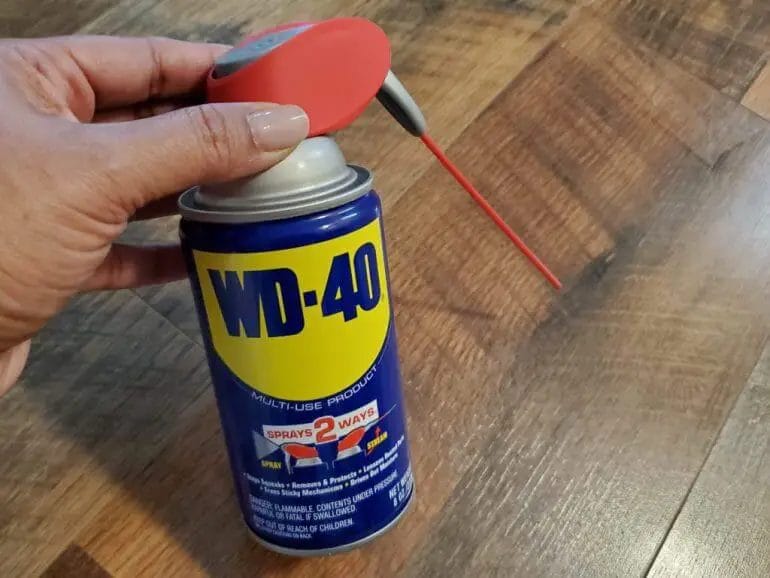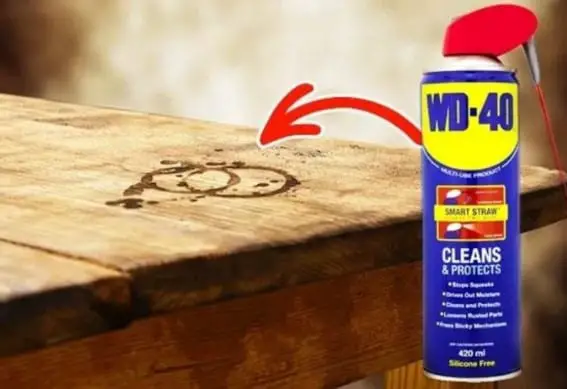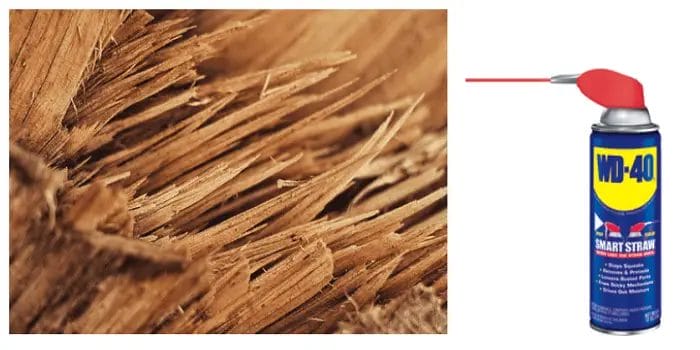If you’re wondering whether WD-40 can be used on wood, the answer is yes! WD-40 is a versatile product that can be safely applied to wood surfaces to provide various benefits. Whether you need to clean, remove adhesives or lubricate hinges, WD-40 can come to your rescue. However, it’s important to use it efficiently and follow proper precautions to avoid any potential damage to the wood. In this article, we will explore the uses of WD-40 on wood and provide you with some helpful tips to make the most out of this trusted lubricant and cleaner.

How to Properly Apply WD-40 on Wood
Wood is a versatile and durable material commonly used in furniture, flooring, and other household items. However, over time, wood can become worn, dried out, or develop squeaks. Applying WD-40 can help rejuvenate and protect the wood, restoring its natural beauty and extending its lifespan. Here are some steps to properly apply WD-40 on wood:

1. Prepare the Surface
Before applying WD-40, ensure that the wood surface is clean and free from dust, dirt, and debris. Use a soft cloth or brush to gently remove any loose particles. This will help the WD-40 penetrate the wood and provide the best results.
2. Shake the Can
WD-40 comes in a spray can, and it is essential to shake it well before using it on wood. This will help mix the ingredients and ensure an even distribution of the product.
3. Test in an Inconspicuous Area
Before applying WD-40 to the entire wood surface, it is wise to test it in a small, hidden area. This will allow you to observe any adverse reactions or discoloration that may occur. Wait for a few minutes to ensure that the wood does not react negatively to the product.
4. Apply WD-40
Once you have tested the product and are satisfied with the results, you can proceed to apply WD-40 on the wood. Hold the can about 6-8 inches away from the surface and spray a light, even coat. Avoid saturating the wood, as excessive WD-40 can lead to a greasy appearance or cause damage.
5. Spread and Wipe Off Excess
After applying WD-40, use a clean, lint-free cloth to spread and wipe off any excess product. This will help ensure an even distribution and prevent a sticky or oily residue. Be sure to follow the wood grain while wiping to maintain a consistent finish.
6. Allow to Dry
Allow the WD-40 to dry completely before using or touching the wood surface. Depending on the climate and conditions, this may take a few hours. Ensure proper ventilation to speed up the drying process.
7. Maintain and Reapply as Needed
To keep your wood surfaces looking their best, it is recommended to regularly maintain and reapply WD-40. Depending on usage and environmental factors, you may need to apply it every few months or as needed. Regular maintenance will help protect the wood from moisture, prevent squeaks, and maintain its natural shine.
By following these steps, you can properly apply WD-40 on wood and enjoy the benefits of revitalized and protected surfaces. Remember to always read and follow the instructions on the WD-40 can, and if in doubt, consult a professional for guidance.

Precautions and Considerations when Using WD-40 on Wood
WD-40 is a versatile product that is commonly used as a lubricant, cleaner, and rust preventative. While it can be effective for various applications, it’s important to exercise caution when using WD-40 on wood surfaces. Here, we will discuss some precautions and considerations to keep in mind to ensure the safety and preservation of your wood.
1. Test in an inconspicuous area:
Before applying WD-40 to a visible area of your wood, it’s essential to test it in a small, inconspicuous spot first. This will allow you to check for any adverse reactions, such as discoloration or damage to the finish. If there are no negative effects, you can proceed with confidence.
2. Protect the surrounding areas:
When using WD-40 on wood surfaces, it’s important to protect the surrounding areas from overspray. WD-40 is known to have a strong odor and can leave residue on nearby surfaces. To prevent any unwanted damage or staining, cover adjacent areas with plastic sheeting or newspaper.
3. Apply sparingly:
When using WD-40 on wood, less is more. Apply the product sparingly to avoid oversaturation, which can lead to discoloration or warping of the wood. A light, even coat should be sufficient for most applications.
4. Wipe off excess:
After applying WD-40, it’s crucial to wipe off any excess product from the wood surface. Leaving excess residue can attract dust and dirt, making it difficult to clean and potentially causing long-term damage to the wood.
5. Avoid using on unfinished wood:
Unfinished or raw wood is more porous and absorbent compared to finished wood surfaces. As a result, using WD-40 on unfinished wood can lead to excessive absorption, which may alter the appearance and compromise the integrity of the wood. It’s best to avoid using WD-40 on unfinished wood and opt for appropriate wood treatments instead.
6. Use a clean cloth:
When applying WD-40 to wood, always use a clean, lint-free cloth. Avoid using abrasive materials, such as steel wool or rough sponges, as they can cause scratches and damage to the wood surface.
7. Maintain proper ventilation:
WD-40 emits strong fumes, which can be harmful when inhaled in enclosed spaces. Ensure that the area where you are using WD-40 on wood is well-ventilated. Open windows and doors, or use fans to dissipate the fumes.
8. Follow up with proper wood maintenance:
While WD-40 can be effective for certain wood maintenance tasks, it’s important to follow up with appropriate wood care. After using WD-40, clean the wood surface with a mild detergent and water solution, then apply a suitable wood polish or protectant to restore shine and protect the wood from future damage.
In summary, while WD-40 can be a useful product for various applications, it’s essential to take precautions and exercise care when using it on wood surfaces. By following the outlined considerations, you can safely and effectively use WD-40 while preserving the beauty and integrity of your wood.

Alternative Products to WD-40 for Wood Maintenance
Wood maintenance is a crucial aspect of ensuring the longevity and beauty of wooden surfaces. While WD-40 is a popular choice for various household uses, it may not always be the best option for wood maintenance. In this section, we will explore alternative products that can effectively clean, protect, and restore wooden surfaces without causing any damage.
1. Lemon Oil
Lemon oil is a natural and gentle alternative to WD-40 for cleaning and maintaining wooden surfaces. It helps to remove dirt, grime, and stains, while also nourishing the wood and enhancing its natural shine. Lemon oil is particularly effective for cleaning and polishing furniture, cabinets, and wooden floors. Simply apply a small amount of lemon oil onto a soft cloth and gently rub it onto the wood surface in a circular motion. Allow it to penetrate the wood for a few minutes, then wipe away any excess oil with a clean cloth.
2. Beeswax Polish
Beeswax polish is another excellent alternative for wood maintenance. It provides a protective layer on the wood surface, preventing moisture from seeping in and helping to maintain its natural luster. Beeswax polish is particularly beneficial for older or worn-out wood, as it can help to restore its original beauty. To apply beeswax polish, first, ensure that the wood surface is clean and dry. Then, using a soft cloth or brush, evenly distribute the beeswax polish onto the wood in the direction of the grain. Allow it to sit for a few minutes, and then buff the surface with a clean cloth to achieve a glossy finish.
3. Olive Oil and Vinegar Mixture
An olive oil and vinegar mixture is a simple yet effective DIY solution for wood maintenance. Olive oil nourishes the wood, while vinegar acts as a natural cleaning agent. Mix equal parts of olive oil and vinegar in a spray bottle and shake well to combine. Spray the mixture onto the wood surface and wipe it clean using a soft cloth. This mixture helps to remove dirt and grime, restore shine, and protect the wood against drying out. However, it is important to note that this mixture should not be used on unsealed or unfinished wood, as it may cause damage.
4. Linseed Oil
Linseed oil is a traditional product used for wood maintenance and preservation. It helps to protect the wood from moisture and UV damage, making it an ideal choice for outdoor wooden surfaces such as decks and furniture. Linseed oil is also effective for reviving dry or dull wood, giving it a renewed appearance. Apply a thin coat of linseed oil onto the wood using a brush or cloth, allowing it to penetrate the surface for a few minutes. Remove any excess oil with a clean cloth and let it dry completely. Repeat the process if necessary to achieve the desired level of protection and shine.
When it comes to wood maintenance, it is important to choose products that are suitable for the specific type of wood and finish. Always test the product on a small, inconspicuous area before applying it to the entire surface. Additionally, follow the manufacturer’s instructions and safety precautions to ensure optimal results and protect your health.
In summary, while WD-40 can be a versatile product for various uses, it may not be the best option for wood maintenance. Lemon oil, beeswax polish, an olive oil and vinegar mixture, and linseed oil are all effective alternatives that can clean, protect, and restore wooden surfaces without causing any harm. Choose the product that suits your specific wood type and enjoy the beauty and longevity of well-maintained wood.
Common Mistakes to Avoid when Using WD-40 on Wood
Using WD-40 on wood can be a helpful solution for various issues, such as loosening stuck screws or removing stains. However, there are some common mistakes that people make when using WD-40 on wood that can cause damage or ineffective results. To ensure you achieve the desired outcome without harming your wood surfaces, it’s important to steer clear of these mistakes:
1. Not Testing on a Small, Inconspicuous Area
Before applying WD-40 to a larger area of your wood, it’s crucial to test it on a small, inconspicuous area first. This will help you determine how the wood will react to the product and minimize the risk of unwanted effects. Apply a small amount of WD-40 to a hidden spot and observe if any negative reactions occur, such as discoloration or damage. If the test area shows no adverse effects, it’s generally safe to proceed with using WD-40 on the rest of the wood surface.
2. Using an Excessive Amount of WD-40
One of the most common mistakes is using too much WD-40 on wood. While WD-40 is a versatile product, using an excessive amount can lead to oversaturation and damage to the wood. It’s important to apply WD-40 in moderation and only use the amount needed to achieve the desired result. Start with a small amount and add more if necessary.
3. Leaving WD-40 on the Wood Surface for Too Long
Leaving WD-40 on the wood surface for an extended period can result in discoloration or damage. It’s important to follow the instructions on the WD-40 product label and remove any excess residue promptly. Use a clean cloth or paper towel to wipe away the WD-40 after it has served its purpose. This will help prevent any unwanted effects on the wood.
4. Not Cleaning the Wood Surface Properly
Prior to using WD-40 on wood, it’s essential to ensure that the surface is clean and free of debris. Dust, dirt, or other particles can hinder the effectiveness of WD-40 and potentially lead to undesirable results. Use a gentle wood cleaner or a damp cloth to clean the wood surface before applying WD-40. This will help the product penetrate effectively and yield better outcomes.
5. Using WD-40 as a Long-Term Solution
While WD-40 can be a temporary fix for certain wood issues, it’s important to remember that it is not a long-term solution. WD-40 is primarily designed for lubrication and may not provide lasting effects on wood surfaces. If you are dealing with more serious wood problems, such as deep stains or structural issues, it’s advisable to consult a professional or use other appropriate wood treatments.
In summary, using WD-40 on wood can be beneficial if done correctly. Avoid common mistakes such as not testing on a small area, using an excessive amount, leaving it on the wood for too long, not cleaning the surface properly, and relying on WD-40 as a long-term solution. By following these guidelines, you can effectively use WD-40 on wood without causing damage and achieve the desired results.
FAQs
Can I use WD-40 on wood?
No, it is not recommended to use WD-40 on wood. WD-40 is a lubricant and solvent that can potentially damage the finish on wood surfaces. It is best to use products specifically designed for wood care and maintenance.
How often should I change the oil in my car?
It is generally recommended to change the oil in your car every 3,000 to 5,000 miles or every 3 to 6 months, whichever comes first. However, it is best to refer to your car’s owner manual for specific recommendations as it can vary depending on the vehicle and type of oil used.
Can I wash my clothes with dish soap?
It is possible to wash clothes with dish soap in a pinch, but it is not recommended for regular use. Dish soap is designed to remove grease and oil from dishes and may not effectively clean clothes or remove stains. It is best to use laundry detergent specifically formulated for clothing.
Conclusion
In conclusion, while WD-40 is a versatile and effective lubricant for various applications, it is not recommended for use on wood surfaces. The petroleum-based formula of WD-40 can potentially damage the finish or penetrate the wood, leading to discoloration or warping. Instead, it is advisable to use specialized wood cleaners or polishes that are specifically designed to protect and enhance the beauty of wooden surfaces.
Furthermore, it is important to consider the specific needs of your wood, such as the type of finish or sealant used, before applying any product. It is always a good idea to test any new product or cleaning solution on a small, inconspicuous area of the wood to ensure compatibility and avoid any potential damage.
By following these guidelines and using appropriate products, you can maintain the integrity and beauty of your wood surfaces for years to come.